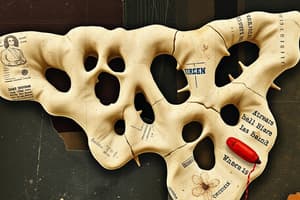Podcast
Questions and Answers
What is the name of the specialized regions in cardiac muscle that have many desmosomes and adherent junctions joining the cells firmly?
What is the name of the specialized regions in cardiac muscle that have many desmosomes and adherent junctions joining the cells firmly?
- Endomysium
- Striations
- Intercalated discs (correct)
- Perimysium
Which structure surrounds the muscle cells in cardiac muscle and contains a rich capillary network?
Which structure surrounds the muscle cells in cardiac muscle and contains a rich capillary network?
- Perimysium
- Desmosomes
- Endomysium (correct)
- Fibrous skeleton
What is the function of sarco-endoplasmic reticulum Ca2+ ATPase (SERCA) in cardiac muscle cells?
What is the function of sarco-endoplasmic reticulum Ca2+ ATPase (SERCA) in cardiac muscle cells?
- To transport calcium ions back into the sarcoplasmic reticulum after muscle contraction (correct)
- To release calcium ions into the cytoplasm during muscle contraction
- To help generate action potentials for muscle contraction
- To facilitate the binding of actin and myosin during muscle contraction
What is the main function of the fibrous skeleton in specific areas of cardiac muscle?
What is the main function of the fibrous skeleton in specific areas of cardiac muscle?
Which part of the cardiac muscle cell plays a crucial role in coordinating excitation-contraction coupling by regulating calcium levels?
Which part of the cardiac muscle cell plays a crucial role in coordinating excitation-contraction coupling by regulating calcium levels?
Which layer of the heart contains Purkinje fibers specialized for impulse conduction?
Which layer of the heart contains Purkinje fibers specialized for impulse conduction?
What type of cells make up the Purkinje fibers in the heart?
What type of cells make up the Purkinje fibers in the heart?
Which layer of the heart typically stains paler due to glycogen filling much of the cytoplasm?
Which layer of the heart typically stains paler due to glycogen filling much of the cytoplasm?
The mesothelium that lines the pericardial space also covers which layer of the heart?
The mesothelium that lines the pericardial space also covers which layer of the heart?
What does the simple mesothelium secrete to prevent friction as the heart beats?
What does the simple mesothelium secrete to prevent friction as the heart beats?
Which layer of the heart includes an endothelium and a subendothelial connective tissue?
Which layer of the heart includes an endothelium and a subendothelial connective tissue?
What is the main function of sarco-endoplasmic reticulum Ca2+ ATPase (SERCA) in cardiac muscle relaxation?
What is the main function of sarco-endoplasmic reticulum Ca2+ ATPase (SERCA) in cardiac muscle relaxation?
Which component is responsible for the Ca2+-stimulated release of Ca2+ in cardiac muscle?
Which component is responsible for the Ca2+-stimulated release of Ca2+ in cardiac muscle?
What is the function of Na+/K+ ATPase in cardiac muscle?
What is the function of Na+/K+ ATPase in cardiac muscle?
Which type of channel opens upon the action potential conducted along the sarcolemma and T-tubules in cardiac muscle?
Which type of channel opens upon the action potential conducted along the sarcolemma and T-tubules in cardiac muscle?
Where is the epicardium located within the cardiac muscle layers?
Where is the epicardium located within the cardiac muscle layers?
What is responsible for forming cross-bridges and initiating the power stroke in cardiac muscle?
What is responsible for forming cross-bridges and initiating the power stroke in cardiac muscle?
Flashcards are hidden until you start studying
Study Notes
Epicardium
- The epicardium is the visceral layer of the pericardium and is covered by the simple mesothelium.
- The mesothelial cells secrete a lubricant fluid that prevents friction as the beating heart contacts the parietal pericardium.
Endocardium
- The endocardium is the lining layer of the heart, consisting of the endothelium and its supportive subendothelial connective tissue.
- It has a middle myoelastic layer of smooth muscle cells and connective tissue, and a deeper connective tissue layer of variable thickness called the subendocardial layer.
- The subendocardial layer in the ventricles contains the conducting (Purkinje) fibers of the heart's impulse conducting network.
- Purkinje fibers are modified cardiac muscle cells joined by intercalated disks but specialized for impulse conduction rather than contraction.
Cardiac Muscle Cells
- Cardiac muscle cells have nuclei, intercalated discs, and striations.
- Surrounding the muscle cells is a delicate sheath of endomysium with a rich capillary network.
- A thicker perimysium separates bundles and layers of muscle fibers and forms larger masses of fibrous connective tissue.
Intercalated Discs
- Transverse intercalated disc regions have many desmosomes and adherent junctions called fascia adherentes, which join the cells firmly.
Excitation-Contraction Coupling in Cardiac Muscle
- Ca2+-stimulated Ca2+ release is the mechanism of excitation-contraction coupling in cardiac muscle.
- Action potentials conducted along the sarcolemma and T-tubules open voltage-gated Ca2+ channels, leading to Ca2+ release from the SR.
- Ca2+ binds to troponin C, leading to the formation of cross-bridges and power stroke.
Cardiac Muscle Relaxation
- Ca2+ concentration in the cytoplasm is reduced by active transport back into the SR and removal of Ca2+ out of the cell through the plasma membrane.
- Myocardium relaxes when Ca2+ concentration is reduced.
Studying That Suits You
Use AI to generate personalized quizzes and flashcards to suit your learning preferences.




